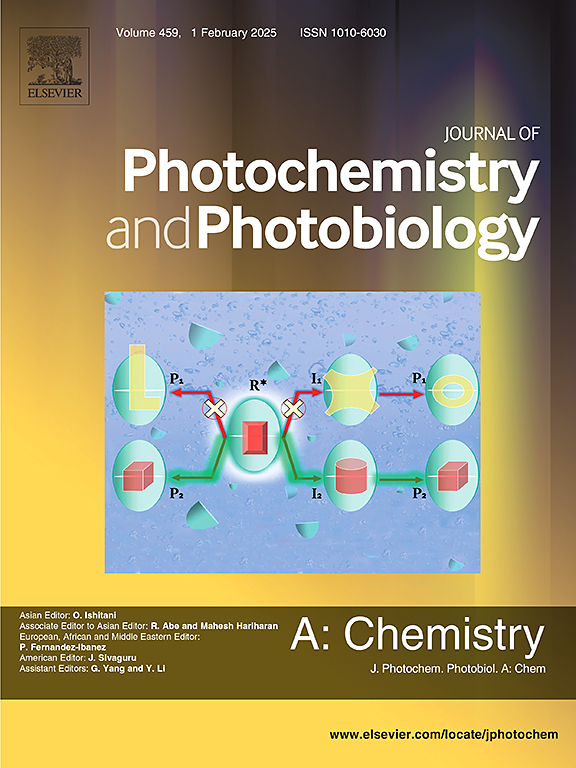Bamboo-derived carbon supported plasmonic ag nanoparticles for visible-light-driven photocatalytic degradation of tetracycline
IF 4.1
3区 化学
Q2 CHEMISTRY, PHYSICAL
Journal of Photochemistry and Photobiology A-chemistry
Pub Date : 2025-07-05
DOI:10.1016/j.jphotochem.2025.116602
引用次数: 0
Abstract
A large number of antibiotics, such as tetracycline (TC), etc., are released into the aqueous system, which poses a great threat to human health and ecological balance. Nowadays, the adsorption method is still a commonly used method to remove the persistent pollutants. However, adsorption materials, such as hierarchical carbon materials, are prone to adsorption saturation, which is uneconomical and requires frequent regeneration. Herein, to address this issue, novel bamboo-derived carbon composite catalysts consisting of N-doped oxygen vacancy-rich TiO2, and Ag nanoparticles (NPs) (Ag-N-TiO2/BC) were prepared and used for the photocatalytic degradation of TC under visible light irradiation. 1 %Ag-N-TiO2/BC(1) was found to have an excellent photocatalytic degradation of TC, with 77 % degradation after 180 min of visible light irradiation, and the kinetic study showed that the reaction rate constant was 0.00686 min−1. The physicochemical and electrochemical properties of the catalysts were systematically characterized by XRD, TEM, XPS, and EIS, etc. Importantly, it is revealed that the introduction of Ag NPs with SPR effect and the presence of oxygen vacancies of N-TiO2 provide a long-term degradation activity of TC, thus avoiding the frequent regeneration of bamboo charcoal (BC). The reaction mechanism study showed that h+ plays a dominant role in the degradation of TC. After four cycles of tests, the degradation rate of TC by this composite catalyst could still reach 69 %, demonstrating its good stability and reusability in the cycling experiment. This study provides a new method for the high-value utilization of BC to fabricate the composite photocatalysts for the long-term and economic removal of antibiotics.

竹子衍生碳负载等离子体银纳米颗粒用于可见光驱动光催化降解四环素
大量抗生素,如四环素(四环素)等被释放到水系统中,对人类健康和生态平衡构成极大威胁。目前,吸附法仍是去除持久性污染物的常用方法。然而,吸附材料,如分级碳材料,容易吸附饱和,不经济,需要经常再生。为了解决这一问题,本文制备了由n掺杂富氧空位TiO2和Ag纳米颗粒(Ag- n -TiO2/BC)组成的新型竹源碳复合催化剂,并将其用于可见光下光催化降解TC。结果表明,1% Ag-N-TiO2/BC(1)具有良好的光催化降解TC的性能,在可见光照射180 min后,降解率达到77%,动力学研究表明,反应速率常数为0.00686 min−1。采用XRD、TEM、XPS、EIS等手段对催化剂的理化、电化学性能进行了系统表征。重要的是,研究揭示了具有SPR效应的Ag NPs的引入和N-TiO2氧空位的存在提供了TC的长期降解活性,从而避免了竹炭(BC)的频繁再生。反应机理研究表明,h+在TC的降解中起主导作用。经过4次循环试验,该复合催化剂对TC的降解率仍可达到69%,表明其在循环实验中具有良好的稳定性和可重复使用性。本研究为高价值利用BC制备长期经济脱除抗生素的复合光催化剂提供了一种新方法。
本文章由计算机程序翻译,如有差异,请以英文原文为准。
求助全文
约1分钟内获得全文
求助全文
来源期刊
CiteScore
7.90
自引率
7.00%
发文量
580
审稿时长
48 days
期刊介绍:
JPPA publishes the results of fundamental studies on all aspects of chemical phenomena induced by interactions between light and molecules/matter of all kinds.
All systems capable of being described at the molecular or integrated multimolecular level are appropriate for the journal. This includes all molecular chemical species as well as biomolecular, supramolecular, polymer and other macromolecular systems, as well as solid state photochemistry. In addition, the journal publishes studies of semiconductor and other photoactive organic and inorganic materials, photocatalysis (organic, inorganic, supramolecular and superconductor).
The scope includes condensed and gas phase photochemistry, as well as synchrotron radiation chemistry. A broad range of processes and techniques in photochemistry are covered such as light induced energy, electron and proton transfer; nonlinear photochemical behavior; mechanistic investigation of photochemical reactions and identification of the products of photochemical reactions; quantum yield determinations and measurements of rate constants for primary and secondary photochemical processes; steady-state and time-resolved emission, ultrafast spectroscopic methods, single molecule spectroscopy, time resolved X-ray diffraction, luminescence microscopy, and scattering spectroscopy applied to photochemistry. Papers in emerging and applied areas such as luminescent sensors, electroluminescence, solar energy conversion, atmospheric photochemistry, environmental remediation, and related photocatalytic chemistry are also welcome.

 求助内容:
求助内容: 应助结果提醒方式:
应助结果提醒方式:


